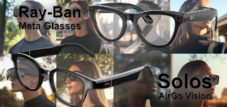Smart glasses with Augmented Reality Light Version – Minimalist and powerful: Next generation smart AR glasses
Xpert pre-release
Language selection 📢
Published on: December 26, 2024 / update from: December 26, 2024 - Author: Konrad Wolfenstein

Smart glasses with Augmented Reality Light Version – Minimalist and powerful: Smart Meta Ray-Ban Glasses as AR glasses – Creative image: Xpert.Digital
Meta x Ray-Ban: Why the new smart glasses could change the market
Smart glasses with Augmented Reality Light Version – Minimalist and powerful: Smart Meta Ray-Ban Glasses as AR glasses
The announcement that Meta is planning a new generation of smart glasses in cooperation with Ray-Ban is generating great interest in the tech industry. With the aim of bringing models with an integrated display onto the market in the second half of 2025, Meta wants to take not only the comfort but also the user experience of its wearables to a new level. Given the growing interest in augmented reality (AR) and mixed reality (MR), this further development seems only logical. “We would like to offer our customers a product that provides useful information in everyday life without sacrificing the aesthetics of classic glasses,” says circles close to the company. But what exactly do the plans look like, why are they important, and what does this mean for the future of wearable technologies? The following sections provide insight into the key aspects surrounding Meta's new Ray-Ban glasses, while also highlighting the broader market development that triggered this announcement.
Background: Why Meta relies on smart glasses
Meta has already shown with the first versions of its Ray-Ban Stories that the company has great ambitions in the area of wearables. The past models offered functions such as photo and video recording as well as audio playback via integrated speakers. “The goal was always to build a bridge between the smartphone and a hands-free, convenient solution,” company spokespersons emphasized at the time. This intention is also evident in the model now planned: Instead of relying only on audio or simple camera applications, Meta would like to install an integrated display in order to project notifications and short information directly into the user's field of vision.
It is no coincidence that Meta develops its smart glasses in collaboration with Ray-Ban: Ray-Ban stands for stylish design, high brand awareness and broad acceptance. After all, most users who are thinking about such glasses don't want to look like they're in a science fiction film, but rather wear a fashionable product. “Smart glasses must be as close as possible to the aesthetics of normal glasses so that they are accepted in everyday life,” is a widely quoted industry credo. This is exactly where Meta comes in and tries to bring comfort and design into harmony.
The integrated display: small window, big impact
The upcoming glasses will have a display that is comparatively small, but still sufficient to display notifications, AI answers and navigation instructions. “We focus on the most important information that people need on the go,” explains a senior engineer. The aim is not to distract the eye too much from the real surroundings. For example, directions can be displayed in the real world without having to constantly look at your smartphone. Messages or warnings can also come directly into the field of vision, which offers practical benefits in many situations.
Another key benefit of this integration is the ability to interact with Meta's AI assistant. Until now, communication often took place via audio output and voice commands. With a built-in display, however, it would be possible to receive short answers or instructions visually. For example, the question “What is the weather today?” could not only display spoken information, but also a small icon with a temperature and weather symbol. This step helps to make the glasses even more useful and independent of excessively loud ambient noise, where purely acoustic interaction would only be possible to a limited extent.
Technical basis: Snapdragon AR1 Gen1 and improved performance
The Qualcomm Snapdragon AR1 Gen1 platform will form the basis for the next generation of Ray-Ban Meta Smart Glasses. This hardware offers significantly more performance than the previous model and allows better photo and video quality. At the same time, it should enable longer battery life. “With the new platform, we can handle several functions at the same time without sacrificing performance and increase energy efficiency,” says a product manager, describing the advantages.
Suitable for:
Battery life plays a crucial role, especially with wearables: Nobody wants to have to charge their smart glasses after just a few hours. The challenge for Meta is to integrate a sufficiently large battery module into a slim, fashionable glasses frame. “It's a balancing act between minimalist design and maximum functionality,” is what the development department repeatedly says. At the same time, efforts are made to keep the heat generated by the display as low as possible so as not to impair wearing comfort.
Market positioning: From gadget to lifestyle product
While the first generations of smart glasses were often perceived as experimental technology, Meta wants to take a step into the mainstream with this product. The close cooperation with Ray-Ban underlines this approach. “Our glasses should not be a niche product that only excites technology freaks, but should become a real part of everyday life,” explains a marketing manager. But in order to achieve this goal, Meta not only has to design the hardware, but also the entire ecosystem harmoniously.
This is where Meta's vision of a closely networked platform comes into play: The smart glasses could connect seamlessly with social media such as Facebook and Instagram and give users the opportunity to take and post pictures or videos directly. At the same time, streaming services or messaging applications could be integrated directly. “With glasses like this you can move in the middle of the digital ecosystem without always having to look at a screen,” is the promise. Whether these functions actually convince users will largely depend on how intuitive and stable the system is.
Competitive situation: Google, Samsung and other players
Parallel to Meta's announcement, Google and Samsung have also deepened their plans for Android XR. Google and Samsung are said to be working on their own headsets and glasses, which could also be released in 2025. This timing coincidence is no coincidence: the industry is in a race to open up new markets for AR and MR devices. “We want to be at the forefront right from the start,” postulate most manufacturers.
So it's no secret that Meta's upcoming Ray-Ban glasses are competing against competitors who have equally big ambitions. Google in particular has extensive experience from projects such as Google Glass, which, however, never made a breakthrough in the mass market. Samsung, on the other hand, scores with a huge hardware portfolio, from smartphones to wearables to TV sets. “We need a product that can be integrated into our existing ecosystem without any hurdles,” is a sentence we often hear from Samsung. The new generation of Metas glasses will have to assert itself in this context and at the same time must manage the balancing act of being attractive in terms of price and technology.
Suitable for:
Orion and other AR projects: Meta's long-term strategy
Meta had already taken a look into the future of the AR world with the “Orion” prototype. These glasses were supposed to offer a much more advanced display, but according to reports they were initially too expensive for mass production. “Users expect innovation, but are often not prepared to spend thousands of euros on it,” admit insiders. That's why Meta is relying on a gradual development of Ray-Ban glasses that doesn't offer fully immersive AR, but still creates enough added value to justify the price.
Suitable for:
The long-term plan is clear: Meta wants to establish itself as a leading provider of AR and MR technologies. “The future will give us glasses that seamlessly merge our environment with digital information,” is what we hear again and again from Meta’s innovation department. The upcoming Ray-Ban glasses are an important interim step that should slowly get the general population used to the advantages of AR. Anyone who already enjoys notifications and navigation aids in their field of vision today could opt for an even more advanced solution tomorrow.
Design and comfort: the balancing act between technology and style
A central feature that often determines the success or failure of smart glasses is the design. Ray-Ban in particular has an iconic design language that is appreciated by many people around the world. “If we change the look of the classic models too much, we will lose the core target group,” point out designers behind the scenes. That's why Meta and Ray-Ban try to keep the appearance as close to the original as possible while using the latest technology inside.
But technology has its price – both in terms of production costs and space requirements. It remains to be seen how Meta and Ray-Ban will ensure that the glasses do not appear bulky or bulky. The developers are faced with the task of cleverly accommodating sensors, batteries, displays and speakers without compromising the aesthetics. “We use every millimeter in the frame to store all the components,” is often emphasized. This fine-tuning of the design will have a major impact on how the glasses ultimately perform in everyday life.
Privacy and security: A sensitive topic
In addition to the technical and aesthetic questions, privacy is also a focus. Wearables with cameras and microphones raise concerns among many people because of their potential to record information without those around them noticing. Meta and Ray-Ban tried to create transparency with LED displays or distinctive signals in the first generations of glasses. Nevertheless, skepticism and concern remain. “We are working to implement clear guidelines and visible notices so that everyone knows when filming or photography is taking place,” is the statement from the company.
There is also the question of how to handle the collected data. Every recorded interaction, photo or video creates digital traces that could be uploaded and processed into Meta's ecosystem. The aim here is to give users extensive control over their own data and to strengthen trust in the platform. Because only when people feel like their privacy is protected will they be willing to wear glasses that operate so close to their face and can potentially record everything.
What could still happen by the second half of 2025
There is still some time until the planned market launch in the second half of 2025. Big leaps can happen in the tech world within a year or two. It is possible that display technology will become even more compact and energy efficient by then, perhaps new cooperation models will emerge with other companies, or Meta will discover a new application that significantly increases the utility of its smart glasses. “We are continually developing our product to respond to people’s needs,” industry representatives regularly emphasize.
The influence of other big players should not be underestimated either. For example, if Apple were to announce or launch its own glasses system, it could dramatically change competition. Samsung and Google, in turn, could implement their Android XR initiative faster than expected and also bring attractive products onto the market. In all this hustle and bustle, Meta needs to clearly define what benefits its Ray-Ban glasses offer and how they stand out from competing offerings.
Suitable for:
A crucial step on the way to the AR revolution
The announced Ray-Ban Smart Glasses with an integrated display mark an important milestone for Meta and the entire industry. While the glasses don't yet offer a fully immersive augmented reality experience, they are a significant step towards a future where AR applications permeate everyday life. “We want to integrate technology into everyday life without it being perceived as disruptive” is a core sentence that you hear from many AR projects. With the planned glasses, this approach could become a good part of reality.
Their pragmatic focus – notifications, AI responses, navigation aids – should offer real-world benefits to many people. The prospect that in just a few years we will be able to perceive road traffic or our surroundings and at the same time have important digital information in view has never been so tangible. We can only hope that Meta, Ray-Ban and the other players in the market deal wisely with data protection and design issues so that the future of smart glasses does not fail due to concerns or a lack of aesthetics.
Overall, it can be said that Meta is making a big statement with these plans. “We are on a path that will lead us to real AR experiences,” is the tenor from company circles. Whether this vision succeeds will largely depend on how well Meta masters the balance between functionality, wearing comfort and data protection. If this succeeds, the next generation of Ray-Ban glasses could be a real trendsetter and give the entire market for wearables and AR technologies a real boost. And who knows – perhaps in the near future such glasses will be as ubiquitous as smartphones are today. In any case, it will be exciting to see how Meta and its competitors take the next steps in this rapidly growing market.
🎯🎯🎯 Benefit from Xpert.Digital's extensive, fivefold expertise in a comprehensive service package | R&D, XR, PR & SEM

AI & XR 3D Rendering Machine: Fivefold expertise from Xpert.Digital in a comprehensive service package, R&D XR, PR & SEM - Image: Xpert.Digital
Xpert.Digital has in-depth knowledge of various industries. This allows us to develop tailor-made strategies that are tailored precisely to the requirements and challenges of your specific market segment. By continually analyzing market trends and following industry developments, we can act with foresight and offer innovative solutions. Through the combination of experience and knowledge, we generate added value and give our customers a decisive competitive advantage.
More about it here:
We are there for you - advice - planning - implementation - project management
☑️ SME support in strategy, consulting, planning and implementation
☑️ Creation or realignment of the digital strategy and digitalization
☑️ Expansion and optimization of international sales processes
☑️ Global & Digital B2B trading platforms
☑️ Pioneer Business Development
I would be happy to serve as your personal advisor.
You can contact me by filling out the contact form below or simply call me on +49 89 89 674 804 (Munich) .
I'm looking forward to our joint project.
Xpert.Digital - Konrad Wolfenstein
Xpert.Digital is a hub for industry with a focus on digitalization, mechanical engineering, logistics/intralogistics and photovoltaics.
With our 360° business development solution, we support well-known companies from new business to after sales.
Market intelligence, smarketing, marketing automation, content development, PR, mail campaigns, personalized social media and lead nurturing are part of our digital tools.
You can find out more at: www.xpert.digital - www.xpert.solar - www.xpert.plus























